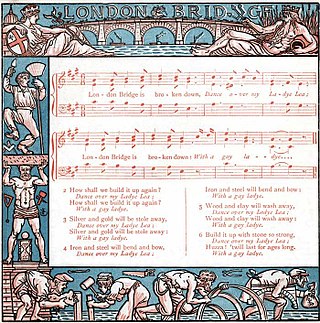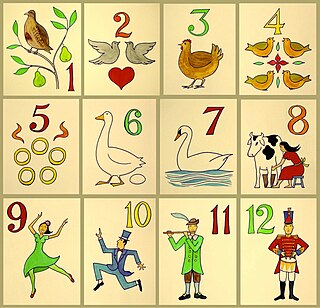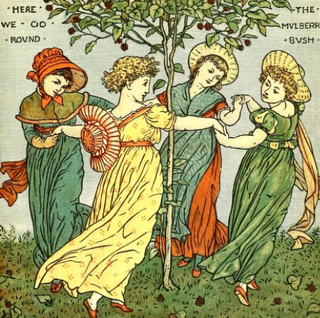Related Research Articles

"Georgie Porgie" is a popular English language nursery rhyme. It has the Roud Folk Song Index number 19532.
"Pop! Goes the Weasel" is a traditional English and American song, a country dance, nursery rhyme, and singing game that emerged in the mid-19th century. It is commonly used in Jack-in-the-box toys and for ice cream trucks.

"Oranges and Lemons" is a traditional English nursery rhyme, folksong, and singing game which refers to the bells of several churches, all within or close to the City of London. It is listed in the Roud Folk Song Index as No 13190. The earliest known printed version appeared c. 1744.

"London Bridge Is Falling Down" is a traditional English nursery rhyme and singing game, which is found in different versions all over the world. It deals with the dilapidation of London Bridge and attempts, realistic or fanciful, to repair it. It may date back to bridge-related rhymes and games of the Late Middle Ages, but the earliest records of the rhyme in English are from the 17th century. The lyrics were first printed in close to their modern form in the mid-18th century and became popular, particularly in Britain and the United States, during the 19th century.

A singing game is an activity based on a particular verse or rhyme, usually associated with a set of actions and movements. As a collection, they have been studied by folklorists, ethnologists, and psychologists and are seen as important part of childhood culture. The same term is also used for a form of video game that involves singing.
"Christmas Is Coming" is a traditional nursery rhyme and Christmas song frequently sung as a round. It is listed as number 12817 in the Roud Folk Song Index.

"Ring a Ring o' Roses", "Ring a Ring o' Rosie", or "Ring Around the Rosie", is a nursery rhyme, folk song and playground singing game. Descriptions first emerge in the mid-19th century, but are reported as dating from decades before, and similar rhymes are known from across Europe, with various lyrics. It has a Roud Folk Song Index number of 7925.

Hunt the thimble is a party game in which one person hides a thimble, or other small object, somewhere in the room, while all other players wait outside. When everyone comes back in, they race to locate the hidden object. The first to find it is the winner, and hides it for the next game.

Pease pudding, also known as pease porridge, is a savoury pudding dish made of boiled legumes, typically split yellow peas, with water, salt and spices, and often cooked with a bacon or ham joint. A common dish in the north-east of England, it is consumed to a lesser extent in the rest of Britain. In Newfoundland, it retains its traditional name as part of the customary Jiggs dinner. In non-English speaking countries, similar dishes exist under different names.
A children's song may be a nursery rhyme set to music, a song that children invent and share among themselves or a modern creation intended for entertainment, use in the home or education. Although children's songs have been recorded and studied in some cultures more than others, they appear to be universal in human society.
"Tinker, Tailor" is a counting game, nursery rhyme and fortune telling song traditionally played in England, that can be used to count cherry stones, buttons, daisy petals and other items. It has a Roud Folk Song Index number of 802. It is commonly used by children in both Britain and America for "counting out", e.g. for choosing who shall be "It" in a game of tag.

"Pease Porridge Hot" or "Pease Pudding Hot" is a children's singing game and nursery rhyme. It has a Roud Folk Song Index number of 19631.
"Frog Went a-Courtin'" is an English-language folk song. Its first known appearance is in Wedderburn's Complaynt of Scotland (1549) under the name "The Frog cam to the Myl dur", though this is in Scots rather than English. There is a reference in the London Company of Stationers' Register of 1580 to "A Moste Strange Weddinge of the Frogge and the Mouse." There are many texts of the ballad; however the oldest known musical version is found in Thomas Ravenscroft's Melismata in 1611.

"Nuts in May" is a singing game played by children with the aim of pairing a boy and girl from within two teams of participants. It was first recorded in the second half of the 19th century and has Roud Folk Song Index 6308.
"Bingo" is an English language children's song and folksong of obscure origin. Additional verses are sung by omitting the first letter sung in the previous verse and clapping or barking the number of times instead of actually saying each letter. Its Roud Folk Song Index number is 589.

"The Muffin Man" is a traditional nursery rhyme, children's song, or children's game of English origin. It has a Roud Folk Song Index number of 7922.

"The Twelve Days of Christmas" is an English Christmas carol. A classic example of a cumulative song, the lyrics detail a series of increasingly numerous gifts given to the speaker by their "true love" on each of the twelve days of Christmas. The carol, whose words were first published in England in the late eighteenth century, has a Roud Folk Song Index number of 68. A large number of different melodies have been associated with the song, of which the best known is derived from a 1909 arrangement of a traditional folk melody by English composer Frederic Austin.

"Here We Go Round the Mulberry Bush" is an English nursery rhyme and singing game. It has a Roud Folk Song Index number of 7882. It uses the tune which Nancy Dawson danced into fame in The Beggar's Opera in mid-1700s London. The same tune is also used for "Lazy Mary, Will You Get Up" and "Nuts in May". A variant is used for "The Wheels on the Bus".
"Oh, Dear! What Can the Matter Be?", also known as "Johnny's So Long at the Fair" is a traditional nursery rhyme that can be traced back as far as the 1770s in England. There are several variations on its lyrics. It has Roud Number 1279.

"Ah! vous dirai-je, maman" is a popular children's song in France. Since its composition in the 18th century, the melody has been applied to numerous lyrics in multiple languages – the English-language song "Twinkle, Twinkle, Little Star" is one such example. It was adapted in Twelve Variations on "Ah vous dirai-je, Maman" by Wolfgang Amadeus Mozart.
References
- Baltimore
- Gomme, Children's Games
- Music and lyrics This website archives a copy of the closed folkinfo.org database
- Columbia State University
- Lyrics
- The British Library - Singing and dancing Audio recording of a variation of the song, Green Peas and Barley Grow, from 1961